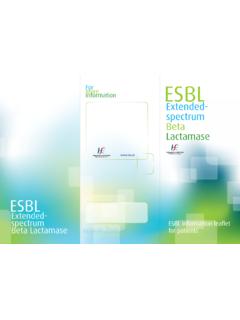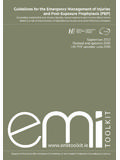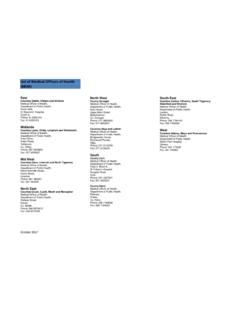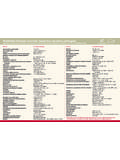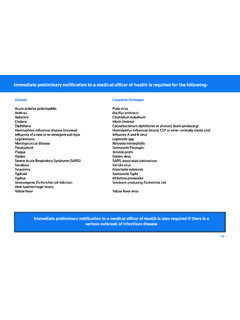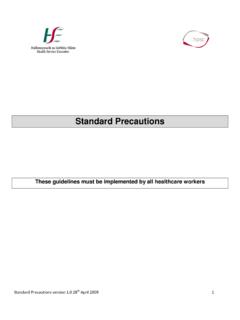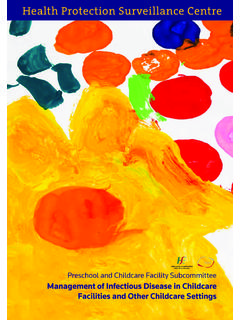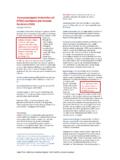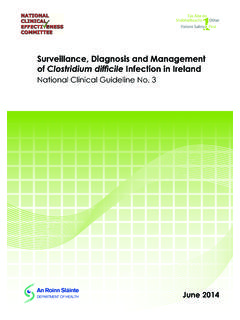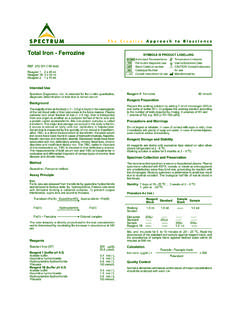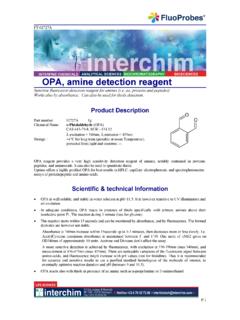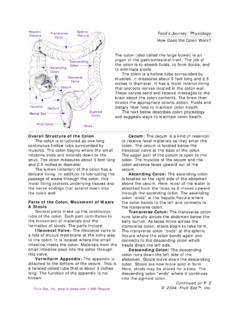Transcription of Appendix 7 HIV Post-exposure prophylaxis (PEP) HIV Post ...
1 ToolkitEMI Guidelines - Appendix 7 HIV Post-exposure prophylaxis (PEP) (updated June 2018)-36-HIV Post-exposure prophylaxis (PEP)Key consider PEP if within 72 hours of first dose of PEP should be given as soon as possible - within 2 hours if risk based on type of exposure and what is known about source (consider risk of HBV and HCV also seerelevant appendices) source if with senior doctor in emergency medicine or HIV specialist if unsure how to PEP blood and starter follow up at ID or GUM clinic before starter pack runs no unprotected sex for 3 the patient management form ( Appendix 1) it will serve as a checklistIntroductionThe use of Post-exposure prophylaxis (PEP) against HIV infection dates back to the early 1990s, when only limited antiviral treatment for chronic infection was available.
2 prophylaxis was primarily used after occupational A case control study published in 1997 showed that health care workers who received zidovudine after needlestick exposures were 81% less likely to undergo seroconversion to positivity for Generally, combination therapies are prescribed nowadays, so current HIV PEP may be more effective. However, PEP is not a guarantee of exposure to HIV through sexual contact or injecting drug use, antiretroviral therapy may also be administered for prophylaxis against infection. No efficacy data are available for this strategy, but substantial safety and feasibility data have led to its widespread General principlesHIV PEP should only be considered in patients who present within 72 hours with a significant exposure from either a known HIV positive person or a suspected high risk source.
3 The first dose of PEP should be given as soon as possible - within 2 hours if should not be offered where testing has shown that the source is HIV negative, or if the risk assessment has concluded that HIV infection of the source is the HIV status of the source is unknown, a careful risk assessment should be carried out. PEP is unlikely to be justified in the majority of such assessmentThe risk of an individual acquiring HIV following an exposure is dependent upon the risk that the source is HIV-positive where unknown, and the risk of infection following a specific exposure from an HIV-positive of HIV transmission = risk that source is HIV-positive x risk of exposure *(*including co-factors such as sexually transmitted infections, high HIV viral load and bleeding).4toolkit-37-EMI Guidelines - Appendix 7 HIV Post-exposure prophylaxis (PEP) (updated June 2018)Table 1 Risk of HIV transmission per exposure from a known HIV-positive individual not on ART (Adapted from BASHH UK Guideline for use of HIV PEPSE 20154 source references omitted from table)
4 Type of exposureEstimated risk of HIV transmission per exposure from a known HIV-positive individual not on ARTR eceptive anal intercourse1 in 90 Receptive anal intercourse with ejaculation1 in 65 Receptive anal intercourse no ejaculation1 in 170 Insertive anal intercourse1 in 666 Insertive anal intercourse not circumcised1 in 161 Insertive anal intercourse and circumcised1 in 909 Receptive vaginal intercourse1 in 1000 Insertive vaginal intercourse1 in 1,219 Semen splash to eye<1 in 10,000 Receptive oral sex (giving fellatio)<1 in 10,000 Insertive oral sex (receiving fellatio)<1 in 10,000 Blood transfusion (one unit)1 in 1 Needlestick injury1 in 333 Sharing injecting equipment (includes chemsex)1 in 149 Human bite<1 in 10,000NB: All sexually related risk probabilities are for unprotected sexual exposure ; it is assumed similar risks will exist where condom failure has occurredThe table above is simply a guide.
5 There are a number of factors that may increase the risk of transmission such as high viral load in the source, and intercurrent STIs, syphilis. The overall number of HIV cases in the UK diagnosed in HCWs following occupational exposures is five documented cases and 31 probable cases, eight of these probable cases being diagnosed prior to 1 9 2 Estimated risk of HIV transmission by type of exposure where source HIV status is unknownType of exposure Population group (% HIV prevalence) Risk of HIV transmission - source HIV status unknown Rounded off estimated risk per exposure (compared with risk if source known HIV+) Receptive anal sex MSM* MSM in Ireland (8%)68/100 x 1/90 = 1/1125 1/1000 (1/90)Insertive anal sex MSM* MSM in Ireland (8%)68/100 x 1/666 = 1/8325 (overall)8/100 x 1/161 = 1/2012 (not circumcised)1/8000 (1/666)1/2000 (1/161)Receptive oral sex MSM* MSM in Ireland (8%)68/100 x 1/10,000 = 1/125,000 1/100,000 (<1/10,000)
6 Receptive vaginal sex Heterosexuals in Ireland ( )7,% x 1/1000 = 1/666,6661/700,000 (1/1000)NSI from unknown non high risk hospital pt Heterosexuals in Ireland ( )7,% x 1/333 = 1/222,0001/200,000 (1/333)NSI from community source PWID in Ireland(5 to10%)8,9, ,& 5/100 x 1/333 = 1/6660 to10/100 x 1/333 = 1/33301/7000 to 1/3000 (1/333)*MSM=men who have sex with men% Of note, the prevalence of diagnosed HIV varies geographically in Ireland with crude prevalence of amongst 17-78 year olds in Dublin. (Patients Accessing Ambulatory Care for HIV-infection: Epidemiology and Prevalence Assessment. Tuite H et al. Ir Med J. 2015 Jul-Aug;108(7):199-202). NSI=needlestick injury PWID=people who inject drugs Personal communications: Dr Shay Keating, Drug Treatment Centre Board and Dr Jean Long, Alcohol and Drug Research Unit, Health Research Of note there has been an increase in the number of recent HIV infections diagnosed amongst PWID in Dublin ( ,15231, )toolkitEMI Guidelines - Appendix 7 HIV Post-exposure prophylaxis (PEP) (updated June 2018)
7 -38-It is generally recommended that HIV PEP is only offered when the estimated transmission risk is 1 in 1000 or greater, but all cases are considered on a case-by-case PEP can be considered in those with a risk of between 1 in 1,000 and 1 in 10,000 only in very exceptional 3 HIV PEP recommendations by type of exposure and source status (Adapted from BASHH UK Guideline 20154 modified to take account of higher prevalence of HIV in PWID population in Ireland compared to UK. The last two rows are not contained in the BASHH Guideline table)Source HIV statusHIV positiveUnknown HIV StatusHIV VL unknown / detectableHIV VL undetectableFrom high prevalence country / risk-group*From low prevalence country / groupReceptive anal sexRecommendNot recommended&Provided source has confirmed HIV Vl<200c/ml for >6 months RecommendNot recommendedInsertive anal sexRecommendNot recommended&Consider Not recommendedReceptive vaginal sexRecommendNot recommended&Consider Not recommendedInsertive vaginal sexConsider%Not recommended&Consider Not recommendedFellatio with ejaculation Not recommended**Not recommendedNot recommendedNot recommendedFellatio without ejaculation Not recommendedNot recommendedNot recommendedNot recommendedSplash of semen into eyeNot recommendedNot recommendedNot recommendedNot recommendedCunnilingusNot recommendedNot
8 RecommendedNot recommendedNot recommendedSharing of injecting equipmentRecommendNot recommendedConsider Not recommendedHuman bite Consider in very limited circumstances** (see Bite algorithm, Appendix 6)Not recommendedNot recommendedNot recommendedNeedlestick from a discarded needle in the communityConsider in very limited circumstances** (see Needlestick/Sharps algorithm, Appendix 3)Not recommendedNeedlestick direct from source**RecommendNot recommendedConsider Not recommendedBlood splash to non-intact skin, eye or mouth**ConsiderNot recommendedNot recommendedNot recommended* High prevalence groups within this recommendation are those where there is a significant likelihood of the source individual being HIV-positive. Within Ireland at present, this is likely to be men who have sex with men, and individuals who have immigrated from areas of high HIV prevalence (particularly sub-Saharan Africa) (See map of global HIV prevalence, Appendix 26)& Provided source s HIV viral load is undetectable for >/= 6 months.
9 Where there is uncertainty about results or medication adherence, PEP should be offered More detailed knowledge of local prevalence of HIV within communities may change these recommendations from consider to recommend in areas/groups of particularly high HIV prevalence%Where source HIV viral load is high ( recent seroconversion) or where there is evidence of genital ulceration PEP is not recommended for individuals receiving fellatio, inserting their penis into another s oral cavity**Consider where recent seroconversion or evidence of oropharyngeal ulceration or trauma. A bite is assumed to constitute breakage of the skin with passage of blood**Denotes parts of table that differ from BASHH GuidelineEstimating probability that source is HIV positiveIn the case of a significant exposure , every effort should be made to ascertain the HIV status of the the source is known, the exposure should be outlined to the source and consent requested for blood to test for HIV Ag/Ab (and HBsAg, anti-HBc and anti-HCV)(appendices 29 & 30).
10 The source is considered HIV negative if there is a recent HIV negative result within the past 3 months plusno clinical indication of a retroviral/ seroconversion-like illness, and source is not considered to be at highrisk of infection. The source is considered HIV positive if they have a positive HIV result, or a physician has diagnosed HIV orthe source self-reports a diagnosis of HIV. A low or undetectable HIV viral load greatly diminishes but doesnot completely eliminate the risk of transmission. PEP should be discussed with the treating ID consultantif the source is on anti HIV medication. If not contactable, commence standard the exposure involves a source person with either unknown HIV status or unknown identity it is not possible to give reassurance that the risk of HIV infection is zero.
